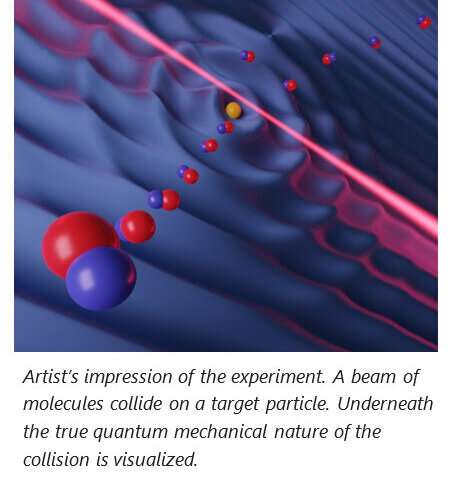Credit: Netherlands Organisation for Scientific Research (NWO)
Collision experiments provide the means for a detailed understanding of molecular interactions at the individual particle level. Theoretical and experimental physicists within the Institute for Molecules and Materials have published a paper in Science in which they fully characterize molecular collisions at temperatures near absolute zero.
"It reveals fundamental laws of quantum mechanics that govern the inner workings of molecular collisions," researchers Tim de Jongh and Matthieu Besemer say.
At low temperatures, the rules of quantum mechanics dictate that molecules behave wavelike. In such cases a molecular collision is more akin to a water wave impinging on a rock than to a collision between billiard balls. A consequence of this wavelike behavior of the molecules in a collision is the occurrence of resonances. At specific collision energies the colliding molecules form a long-lived complex, a so-called resonance, before they fly apart. At these specific energies the scattering behavior differs strongly from that at nearby energies, since the molecules stay together for a longer time and the interactions between them have a much stronger effect on the outcome of the collision.
The interactions between molecules can be quantitatively expressed in the form of an "interaction potential." Quantum mechanics offers the possibility to obtain such interaction potentials from advanced "ab initio" calculations and, subsequently, to use them in "quantum scattering" calculations that predict the outcome of collision experiments. When the results agree with the experimental data, it is confirmed that the ab initio calculations are accurate. Previous collaborations between the experimental group of Prof. Bas van de Meerakker and the theoretical group of Prof. Gerrit Groenenboom have demonstrated that this is a very useful tool to get a detailed and accurate understanding of the interactions between molecules.
Low Energy Collisions
In the experiments described in the Science paper the researchers were able to detect resonances in collisions at temperatures just above absolute zero. "At these extremely low temperatures the detail at which we can observe the interaction between molecules is greatly enhanced due to the presence of resonances and we can use this to sensitively test the ab initio calculations," Tim de Jongh, Ph.D. researcher in the Spectroscopy of Cold Molecules group of Bas van de Meerakker, explains.
However, the experimental results did not match the theoretically calculated results. "Interaction potentials calculated with the method that is generally known to be the 'golden standard' were sufficiently accurate to reproduce all previous experimental data. But for these measurements we had to extend the calculation of the interaction potential beyond the standard theory," Matthieu Besemer, Ph.D. researcher in the Theoretical Chemistry Group of Gerrit Groenenboom, clarifies. The challenges stem from the difficulty in accurately describing the interactions between the large number of electrons that are present in the molecular complex. By using ab initio calculations beyond the 'golden standard," agreement between experiment and theory was obtained. "The synergy between the two disciplines and groups allowed us to obtain agreement, and to enhance our understanding of how quantum mechanics governs molecular interactions," Besemer and De Jongh add.
Het Controlling Collisions
The researchers have shown that by reducing the interactions to their most elemental forms the minutest effects could be observed. "At these low temperatures, molecular interactions become susceptible to external influences such as electric fields. Ultimately, this means we will be able to tune and even control collisions using external fields." This creates the prospect of not only probing molecular collisions with the highest possible detail but also manipulating collisions with the highest degree of control.
More information: Tim de Jongh et al. Imaging the onset of the resonance regime in low-energy NO-He collisions, Science (2020). DOI: 10.1126/science.aba3990
Journal information: Science
























